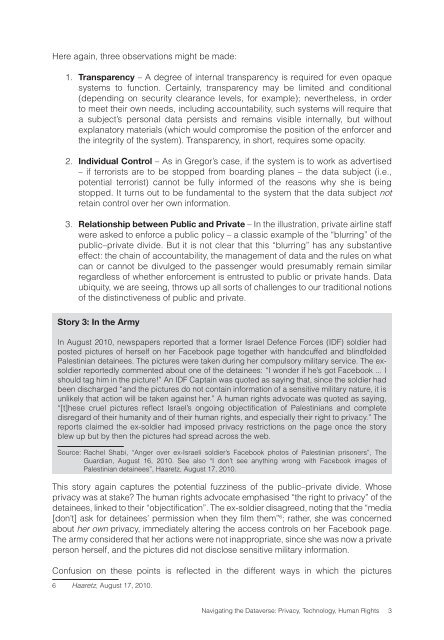Navigating the Dataverse: Privacy, Technology ... - The ICHRP
Navigating the Dataverse: Privacy, Technology ... - The ICHRP
Navigating the Dataverse: Privacy, Technology ... - The ICHRP
Create successful ePaper yourself
Turn your PDF publications into a flip-book with our unique Google optimized e-Paper software.
Here again, three observations might be made:<br />
1. Transparency – A degree of internal transparency is required for even opaque<br />
systems to function. Certainly, transparency may be limited and conditional<br />
(depending on security clearance levels, for example); never<strong>the</strong>less, in order<br />
to meet <strong>the</strong>ir own needs, including accountability, such systems will require that<br />
a subject’s personal data persists and remains visible internally, but without<br />
explanatory materials (which would compromise <strong>the</strong> position of <strong>the</strong> enforcer and<br />
<strong>the</strong> integrity of <strong>the</strong> system). Transparency, in short, requires some opacity.<br />
2. Individual Control – As in Gregor’s case, if <strong>the</strong> system is to work as advertised<br />
– if terrorists are to be stopped from boarding planes – <strong>the</strong> data subject (i.e.,<br />
potential terrorist) cannot be fully informed of <strong>the</strong> reasons why she is being<br />
stopped. It turns out to be fundamental to <strong>the</strong> system that <strong>the</strong> data subject not<br />
retain control over her own information.<br />
3. Relationship between Public and Private – In <strong>the</strong> illustration, private airline staff<br />
were asked to enforce a public policy – a classic example of <strong>the</strong> “blurring” of <strong>the</strong><br />
public–private divide. But it is not clear that this “blurring” has any substantive<br />
effect: <strong>the</strong> chain of accountability, <strong>the</strong> management of data and <strong>the</strong> rules on what<br />
can or cannot be divulged to <strong>the</strong> passenger would presumably remain similar<br />
regardless of whe<strong>the</strong>r enforcement is entrusted to public or private hands. Data<br />
ubiquity, we are seeing, throws up all sorts of challenges to our traditional notions<br />
of <strong>the</strong> distinctiveness of public and private.<br />
Story 3: In <strong>the</strong> Army<br />
In August 2010, newspapers reported that a former Israel Defence Forces (IDF) soldier had<br />
posted pictures of herself on her Facebook page toge<strong>the</strong>r with handcuffed and blindfolded<br />
Palestinian detainees. <strong>The</strong> pictures were taken during her compulsory military service. <strong>The</strong> exsoldier<br />
reportedly commented about one of <strong>the</strong> detainees: “I wonder if he’s got Facebook ... I<br />
should tag him in <strong>the</strong> picture!” An IDF Captain was quoted as saying that, since <strong>the</strong> soldier had<br />
been discharged “and <strong>the</strong> pictures do not contain information of a sensitive military nature, it is<br />
unlikely that action will be taken against her.” A human rights advocate was quoted as saying,<br />
“[t]hese cruel pictures reflect Israel’s ongoing objectification of Palestinians and complete<br />
disregard of <strong>the</strong>ir humanity and of <strong>the</strong>ir human rights, and especially <strong>the</strong>ir right to privacy.” <strong>The</strong><br />
reports claimed <strong>the</strong> ex-soldier had imposed privacy restrictions on <strong>the</strong> page once <strong>the</strong> story<br />
blew up but by <strong>the</strong>n <strong>the</strong> pictures had spread across <strong>the</strong> web.<br />
Source: Rachel Shabi, “Anger over ex-Israeli soldier’s Facebook photos of Palestinian prisoners”, <strong>The</strong><br />
Guardian, August 16, 2010. See also “I don’t see anything wrong with Facebook images of<br />
Palestinian detainees”, Haaretz, August 17, 2010.<br />
This story again captures <strong>the</strong> potential fuzziness of <strong>the</strong> public–private divide. Whose<br />
privacy was at stake? <strong>The</strong> human rights advocate emphasised “<strong>the</strong> right to privacy” of <strong>the</strong><br />
detainees, linked to <strong>the</strong>ir “objectification”. <strong>The</strong> ex-soldier disagreed, noting that <strong>the</strong> “media<br />
[don’t] ask for detainees’ permission when <strong>the</strong>y film <strong>the</strong>m” ; ra<strong>the</strong>r, she was concerned<br />
about her own privacy, immediately altering <strong>the</strong> access controls on her Facebook page.<br />
<strong>The</strong> army considered that her actions were not inappropriate, since she was now a private<br />
person herself, and <strong>the</strong> pictures did not disclose sensitive military information.<br />
Confusion on <strong>the</strong>se points is reflected in <strong>the</strong> different ways in which <strong>the</strong> pictures<br />
Haaretz, August 17, 2010.<br />
<strong>Navigating</strong> <strong>the</strong> <strong>Dataverse</strong>: <strong>Privacy</strong>, <strong>Technology</strong>, Human Rights
















